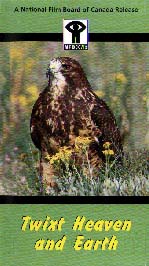|
________________
CM . . . .
Volume V Number 19 . . . . May 21, 1999
This video is about the damage that human actions can do to one species.
In this case, the species is the Swainson's hawk, a raptor that has graced
western Canada for thousands of years. It migrates up to 11,000 km twice a
year, and its status affects a whole hemisphere, from Saskatchewan to the
pampas of Argentina. It is in danger in both areas from changes to its
environment. This video attempts to explain these dangers, illustrating
them by graphic means.
The video starts with its narrator, Dr. Stuart Houston, banding the legs
of hawk chicks on the Saskatchewan prairie. The light of these hawks in
their Northern nesting grounds is dire as the number of suitable trees
decreases annually, with up to 70% of nests failing. Numbers of Swainson's
hawks stand at less than half of 1987 populations.
Some time is spent explaining how science has increased the amount of
knowledge about this species: two years of data gathered using satellite
radio telemetry, which is demonstrated, has given scientists more
information than 70 years of bird banding. The story is picked up again as
thousands of hawks gather in the pampas of Argentina, where the hawks face
a very different sort of danger.
Swainson's hawks are called "grasshopper hawks" in Argentina, after their
main food. The video covers the horrifying results of pesticide used by
farmers to eradicate the grasshoppers. It shows a pile of 700 of the 5,000
birds killed as a result of pesticide use in 1997. This is a very
effective illustration of the dangers of pesticide, but the image should
be taken into consideration by teachers intending to use this video in
classes of younger children. Changes and cooperative ventures between
governments, nature conservatories and the drug company that produced the
pesticide are used as a final note of hope for the future of these birds.
The video ends with the hawks returning once again to Saskatchewan, to the
delight of Dr. Houston.
This video is very clear and precise, without the use of complicated
jargon or terminology. The concentration on this one indicator species
serves as a warning about the possible future for other species. This
video would serve as a valuable illustration for a discussion about
ecology, endangered species or changing biospheres.
Recommended.
Betsy Fraser is a librarian with Calgary Public Library.
To comment on this title or this review, send mail to cm@umanitoba.ca.
Copyright © the Manitoba Library Association.
Reproduction for personal use is permitted only if this copyright notice
is maintained. Any other reproduction is prohibited without
permission.
Published by
TABLE OF CONTENTS FOR THIS ISSUE - MAY 21,
1999.
AUTHORS |
TITLES |
MEDIA REVIEWS |
PROFILES |
BACK ISSUES |
SEARCH |
CMARCHIVE |
HOME
|

